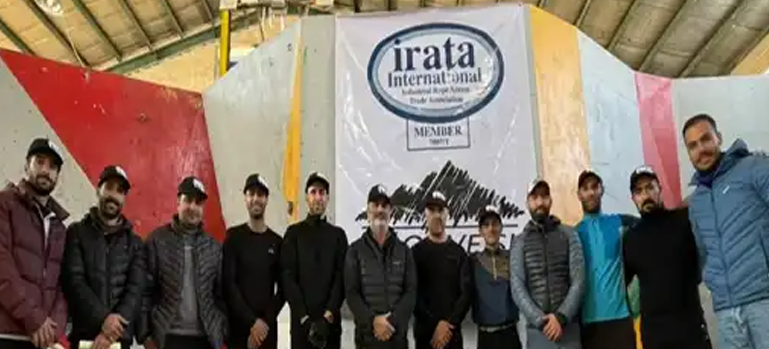what is Irata

- article
- 0
Rope access operations can only be carried out safely when all technicians have completed the required training and possess the necessary qualifications, relevant expertise, and sufficient experience.
1. Introduction & Training Qualification
Obtaining an International Rope Access Certificate
Rope access work can only be performed safely when all operators have successfully completed the required training, possess the necessary qualifications, and have sufficient relevant experience.
They must be capable of performing their assigned tasks according to the approved work procedure and under the supervision of a professional IRATA Level 3 supervisor or instructor, while strictly adhering to the rope access safety regulations set by the international association.
Through our international partner company, interested applicants can successfully complete the International Rope Access Certification Program and, upon qualification, be recognized as IRATA-certified international technicians, categorized by level according to their expertise and professional experience.
Imen Balabaran Kahkeshan (Dr. Ayegh Holding), with its highly skilled and experienced team, is capable of performing rope access operations across Gilan Province and other regions under full safety protocols, utilizing lifeline systems and certified equipment, ensuring quality and customer satisfaction.
2. About IRATA and Its History
IRATA (Industrial Rope Access Trade Association) was established as the global authority for industrial rope access to promote safety, standardization, and professional competency in work-at-height operations.
The core mission of IRATA—encompassing all other objectives—is to develop and continuously improve safety systems and procedures at both national and international levels.
All companies operating under IRATA regulations are required to undergo regular audits to ensure compliance with its technical and quality standards. Since 1992, every individual involved in rope access and related industrial sectors has been required to successfully complete IRATA-certified training programs.
Nearly a decade after its establishment, a large and growing community of highly trained and qualified rope access professionals entered the global workforce. These technicians combined technical skill with a deep understanding of safety principles, allowing rope access companies to offer a wide range of specialized services—enabling clients to benefit from safe, efficient, and reliable solutions.
Across the world, tasks and projects that were once difficult, expensive, and unsafe to access are now performed by rope access teams with significantly higher safety standards. This development has revolutionized the global work-at-height industry. Rope access is now recognized as one of the three safest methods in the industrial and construction sectors.
Rope access technicians are categorized into three levels—Level 1, Level 2, and Level 3—each authorized to perform only the tasks defined for their respective level. Cooperation, communication, and adherence to safety protocols are integral parts of every team’s operation.
Before starting any project, a Level 3 Supervisor must conduct a comprehensive safety assessment—including identification of risks, dangers, and potential hazards—in collaboration with the client organization. Work is not permitted to begin until all necessary permits and authorizations, such as PPE inspection, Tool Box Meeting (TBM), and Permit to Work (PTW), have been issued.
This professional safety culture has profoundly influenced even traditional construction practices, encouraging companies to operate under structured, regulation-based systems led by certified rope access experts.
3. IRATA Levels & Training Structure
The primary reason that IRATA certification is recognized as the most reputable international qualification in rope access is its exceptional safety record, operational efficiency, and the accuracy of its structured training system.
Such excellence has been achieved only through precise planning, a clear hierarchy of competence, and a systematic approach to training and certification.
Rope access can only be performed safely when all operators have undergone the required training, obtained the appropriate qualifications, and gained sufficient hands-on experience.
Each technician must be able to correctly use and inspect the equipment they work with—either independently or under the supervision of a qualified Level 3 Supervisor.
To achieve this, IRATA has developed a progressive and level-based training and certification system, which classifies technicians according to their knowledge, experience, and skill level.
This framework is clearly outlined in the IRATA Training, Assessment, and Certification Scheme (TACS) and consists of the following three levels:
IRATA Level 1 – Rope Access Technician
A Level 1 technician is trained to perform specific, defined rope access tasks under the direct supervision of an IRATA Level 3 Supervisor.
Training Duration: 4 days of training + 1 day of assessment.
IRATA Level 2 – Lead Technician / Rescue Technician
A Level 2 technician is capable of setting up rope access systems, performing rescues, and executing a wide range of tasks under the direction of a Level 3 Supervisor.
Training Duration: 5 days of training + 1 day of assessment.
IRATA Level 3 – Supervisor / Safety Manager
A Level 3 technician is qualified to take full responsibility for all rope access operations.
They possess comprehensive knowledge of relevant standards and regulations, advanced rescue techniques, and first aid certification.
Level 3 technicians are authorized to supervise and assess Level 1 and Level 2 personnel and ensure all operations are carried out in compliance with IRATA and HSE requirements.
Training Duration: 6 days of training + 1 day of assessment.
Revalidation and Refresher Training
All IRATA certifications must be renewed every three years from the date of the initial assessment.
Revalidation includes a comprehensive reassessment of the technician’s practical and theoretical knowledge and consists of three days of training followed by an official assessment relevant to the certified level.
